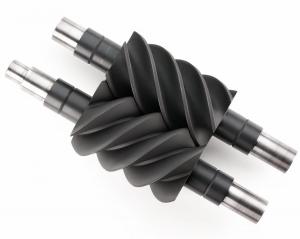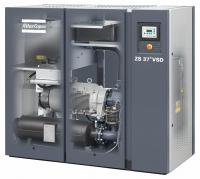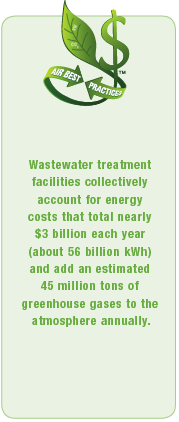|
A Rotary Screw Blower Package with Variable Speed Drive |
The Numbers Don’t Lie
It’s a popular saying everyone has heard before, applied to a variety of situations – political statistics, figures backing up an athlete’s performance and budget data.
Thirty percent is a big number. Applied to the above scenarios, it could entail a landslide victory or a hitter gaining entry into the Baseball Hall of Fame. But just imagine, if the manager of a wastewater treatment facility were to trim 30 percent from their operating costs, he or she might also consider that a landslide victory of their own.
Energy costs are a central figure in facility management, and, in many areas of the country, they have more than doubled in recent years. Appropriately, energy conservation and the associated cost savings, as well as a mitigated impact on the environment, have become primary factors for today’s facility managers.
Air Blowers
Air blowers are critical to this process but can consume a large amount total electricity costs required for wastewater treatment. Consider these quick facts from  the Environmental Protection Agency about energy use at wastewater treatment facilities:
the Environmental Protection Agency about energy use at wastewater treatment facilities:
- About 3 percent of the total energy usage in the United States is used to power processing operations at drinking water and wastewater treatment facilities
- Wastewater treatment facilities collectively account for energy costs that total nearly \$3 billion each year (about 56 billion kWh) and add an estimated 45 million tons of greenhouse gases to the atmosphere annually
- In a typical biological wastewater treatment plant, the aeration blower system alone can account for up to 70 percent of the facility’s entire energy usage.
When costs loom this large, it’s easy to see that even a little savings goes a long way. Even an annual energy savings of just 10 percent in this sector could collectively save about \$400 million every year. Multiply these figures by three and the impact is tremendous.
Rotary Screw Blowers
In aerobic wastewater treatment, bacteria feed on organic waste and break it down into carbon dioxide, nitrogen and water. Because the bacteria need oxygen as part of this process, large quantities of air are bubbled into aeration tanks. To help reduce energy use, Atlas Copco has introduced an entire line of ZS screw blowers that replace the conventional technology represented via the rotary lobe positive displacement blower. This new and proven energy-efficient range for air blowing applications has been demonstrated in third-party independent testing to average 30 percent more energy-efficient operation than conventional lobe blower technology. Saving 30 percent is not the product of myths or dreams anymore.
The 150-year-old technology employed in rotary lobe positive displacement blowers uses two or three lobed rotors that spin inside a casing, drawing air into the blower and pushing it through the outlet. Air pressure throughout the process remains constant, until the rotor lobes uncover the exit port. Some air from the discharge piping flows back into the blower, increasing pressure and reducing volume in the trapped pocket. The rotor lobes continue to turn until this volume of air is pushed out of the casing. The process results in high pressure pulsations and the classic ‘thumping’ noise or ‘whine.’
The technology employed with the new screw blowers is essentially a scaled version of the principles used in an air compressor. Paired male and female rotors trap and then squeeze air between them. Air is progressively compressed during each rotation.
At the start of the compression cycle, air fills the space between the fluted and lobed rotor. As the rotors turn, the intake closes, trapping a given volume of air. The rotors continue to turn, reducing the volume between the male and female rotor halves. The rotors continue to mesh with one another until the air exits the outlet port.

Side-by-Side Comparison by TÜV
Because the process of compression occurs internally, less energy is required to move the compressed air to its end use.
To compare the performance of a rotary lobe blower versus an oil-free screw blower, laboratory testing was conducted comparing the two technologies in the same environment under equal operating conditions. The energy consumed by each machine was measured at the power source, as was the flow levels at each machine’s respective outlet.
 In a recent case study, when screw blower and rotary lobe technologies were examined in side-by-side comparisons under identical conditions – 2,000 CFM for 8,760 hours, or one year, at \$.052/kWh – the screw blower technology realized a savings of nearly \$15,000 a year, or \$150,000 over 10 years, compared to conventional rotary lobe positive displacement blowers.
In a recent case study, when screw blower and rotary lobe technologies were examined in side-by-side comparisons under identical conditions – 2,000 CFM for 8,760 hours, or one year, at \$.052/kWh – the screw blower technology realized a savings of nearly \$15,000 a year, or \$150,000 over 10 years, compared to conventional rotary lobe positive displacement blowers.
In this particular test, a tri-lobe rotary blower was sized with a 110 kW motor and connected to a separately installed frequency converter. For comparison, an oil-free screw blower was fitted with a 75 kW motor with an integrated frequency drive. The resulting measurements taken at maximum volume flow of each machine showed that the rotary lobe displacement blower needed an average 32 percent more energy to move the same amount of air.
Additional testing conducted by the Technische Überwachungs-Verein (German Technical Monitoring Association, or TÜV), an independent, third-party organization, witnessed the testing and then compared the performance of the new oil-free screw blower against a tri-lobe blower (TÜV Certification is often compared to both ISO Standards and Underwriters Laboratories certifications in the U.S.; German-made automobiles also are not cleared for operation in that country until the receive TÜV Certification). Test results showed that the screw blower averaged a 23.8 percent betterment improvement in energy efficiency than a tri-lobe blower at 0.5 bar(e)/7 psig and showed a 39.7 percent improvement at 0.9 bar(e)/13 psig.
Sound, Range, and Temperature Considerations
As a side benefit of the screw blower technology, these energy efficient blowers are also significantly quieter, operating at 75 dBa versus the 85 to 90 dBa of rotary lobe blowers. That’s a difference comparable to exposure to the noise levels in a busy restaurant (about 80 dBa) versus standing next to a running lawnmower (about 90 dBa). And, as an indication of how much better these noise levels are for employees, the Occupational Safety and Health Administration (OSHA) mandates that employers must administer a continuing hearing conservation program for employees who experience occupational noise levels that meet or exceed an eight-hour period of exposure level to 85 dBa. No additional or special precautions to safeguard the employee’s exposure are mandated below this level.
Equally as important, the discharged air temperature from a screw blower is, on average, about 40 degrees Fahrenheit less than a lobe blower, giving wastewater plants many more options on the piping systems they can utilize.
Where this screw blower technology really outshines traditional technology is its very broad operating range. The rotary screw technology can operate from 100 percent capacity to 25 percent capacity with very little change in specific power. This means as the plant’s biological demand changes, the blower can adapt its capacity to the demand and provide greatly improved overall operational efficiency.
Conclusion
Wastewater treatment facilities provide critical functions that know no holidays or weekends. Because manufacturing facilities and residents in cities and towns depend on clean water, it is essential that these operations continue without fail. Embracing new technology, that has been proven to cut costs by as much as one-third, without compromising quality, is also essential for managers who consider the bottom line equally as important.
For more information visit www.atlascopco.us.






